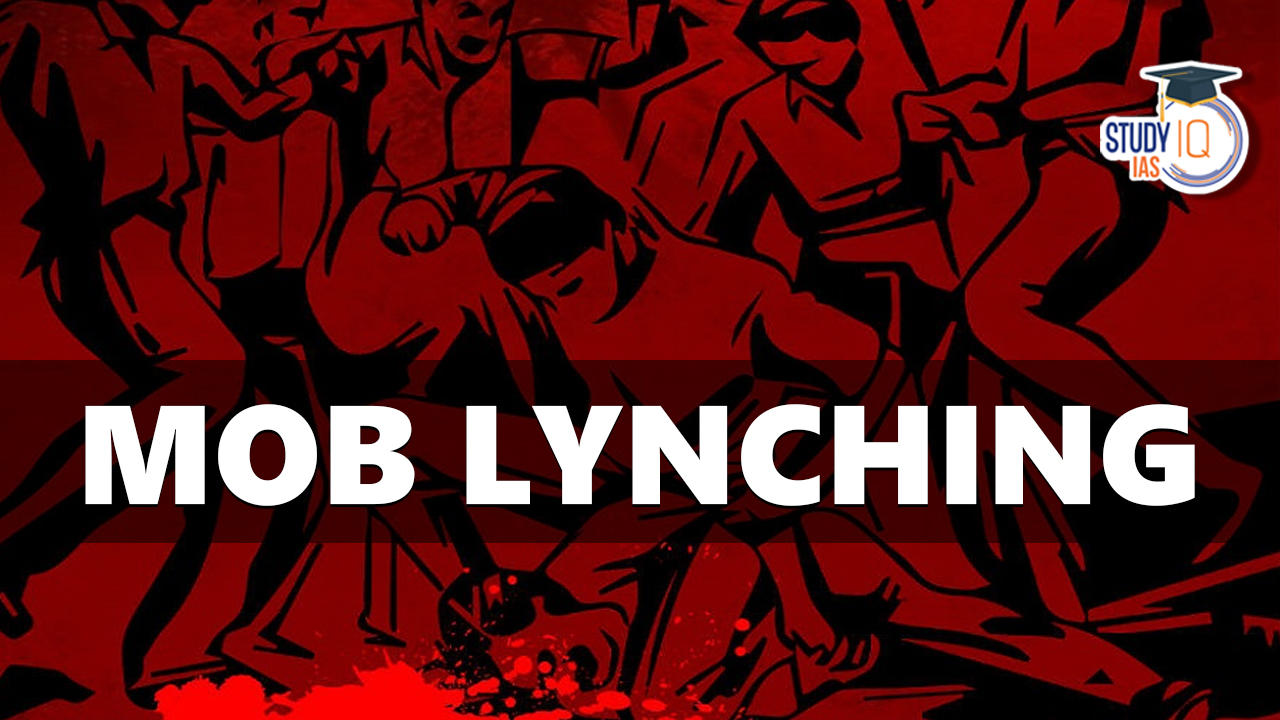Table of Contents
Context: The Supreme Court has decided to review the actions taken by the Union and State governments to address incidents of mob lynchings.
What is Mob Lynching?
- Mob lynching is a form of violence in which a mob, under the pretext of administering justice without trial, executes a presumed offender, often after inflicting torture.
- It is an illegally authorized way of punishing somebody by an informal group. It is most often also referred as informal public executions by a mob who wish to punish an alleged transgressor, or to intimidate a group.
- Such incidents are egregious manifestations of prejudice, intolerance, and contempt towards the rule of law.
Factors Responsible for Mob Lynching in India
- Mob Psychology: People feel less fear of punishment when acting in groups, as it becomes harder to identify individual culprits.
- Administrative Failure: The perception that culprits often go unpunished, particularly in heinous crimes like rape, child abduction, and cow slaughter, contributes to vigilantism.
- Rumors on social media: Misinformation and propaganda spread through platforms like Facebook and WhatsApp have led to impulsive acts of violence.
- Political Patronage: Competitive electoral politics has led to the mobilization of voters based on social divisions and the use of violence to gain support and intimidate opponents.
- Societal factors: The concept of “instant” justice is popular, and the sociopolitical framework of the country involves deep fissures, prejudices, and biases based on factors such as caste and religion.
- Cattle Protection Laws: In certain states, laws related to cattle protection place the burden of proof on the victims, leading to a presumption of guilt. This results in cases being filed against the victims themselves, criminalizing certain professions such as transportation, butchery, and leather work.
The Rising Trend of Mob Lynchings in India
- According to an India Spend analysis, the number of incidences of mob lynching is increasing every year.
- In 2020, India witnessed 23 incidents of mob lynching as against 107 incidents in 2019 as per the reportage in the media. These 23 incidents claimed 22 lives.
Case studies on Mob Lynching
- Palghar mob Lynching case: On April 16, 2020, a driver and two Sadhus were brutally killed by an angry mob in Maharashtra’s Palghar district. The incident was triggered by a WhatsApp rumor claiming the presence of thieves in the village during the COVID-19 lockdown.
- Dadri Lynching case: It took place in Bisra Village, Uttar Pradesh in 2015, involved the brutal killing of Mohammad Akhlaq. He was accused of slaughtering a cow for consumption, and the incident stemmed from regional and communal differences.
Why Mob Lynching is a Cause of Concern?
- Rise of a retributive society: The increasing cases of lynching indicate the emergence of a retributive society in India, where instead of seeking legal justice, people resort to taking revenge to satisfy themselves.
- Violation of the rule of law: Lynching acts directly challenge the established rule of law and undermines the authority of the legal system and creates a sense of lawlessness and vigilantism.
- Violation of Rights: Mob lynching is a violation of human dignity, Article 21 of the Constitution, and a gross infringement of the Universal Declaration of Human Rights.
- Such incidents also violate the Right to Equality and Prohibition of discrimination, which are enshrined in Articles 14 and 15 of the Constitution of India.
- Fear psychosis: Lynchings are intended to instill fear and serve as warnings to others. They create a climate of fear in society, particularly for minority communities.
- Fueling communalism and casteism: The majority of lynching victims belong to vulnerable sections of society, such as religious minorities, lower castes, and nomadic tribes. This perpetuates communal and caste tensions, posing a threat to India’s secular fabric and diversity.
- Contradiction to Indian societal values: Mob lynching goes against the core values of Indian society, including peace, harmony, and tolerance.
- Sign of an immature society: Mob lynching incidents reflect an immature society where differences in opinions are not tolerated or accommodated by its members.
- Economic impact: The stricter laws on cow slaughter, transportation of cattle, and mob attacks by cow protection groups have disrupted not only the cattle trade and rural agricultural economy but also industries linked to farming, dairy, leather, and meat exports.
Legal Provisions on Mob Lynching in India
- Section 223(a) of the Criminal Procedure Code, 1973 contains the provision for persons being charged for an offense jointly when they are accused of the same offence committed in the course of the same transaction which is applicable on two or more people.
- The Indian Penal Code (IPC), 1860 also has some proximate sections related to hate speech and hate crimes under Sections 153A (promoting enmity between different groups and doing acts prejudicial to maintenance of harmony), 153B (imputation, assertions prejudicial to national integration).
- Section 34 of the Indian Penal Code provides punishment for acts done by several persons in furtherance of common intention, where each person is equally liable for the act.
- Section 120B (criminal conspiracy), 147 (rioting), 148 (rioting armed with deadly weapons) and 143/149 (unlawful assembly) of Indian Penal Code are some other provisions related to offences against public tranquility.
- Punishment for lynching may come under Section 302 (murder), 304(culpable homicide not amounting to murder), 307 (attempt to murder) etc.
Government Steps Taken So Far
- States such as Manipur, West Bengal and Rajasthan have passed laws against mob lynching.
- The State Law Commission of UP recommended jail terms ranging from seven years to life imprisonment for those convicted for mob lynching. In its draft legislation, the commission also recommended, “up to three-year term for dereliction of duty by a police officer or a district magistrate.”
- Schemes like Ek Bharat Shrestha Bharat also help strengthen communal harmony and reduce such tensions’ incidence.
Supreme Court Observations on Mob Lynching
- In Tehseen Poonawalla vs Union of India, 2018, Supreme Court condemned recent incidents of lynching and mob violence against Dalits and minority community members as “horrendous acts of mobocracy”, and asked Parliament to pass law establishing lynching as a separate offence with punishment.
- Such a law should be effective enough to instill a sense of fear in the perpetrators.
- SC said that such incidents “threaten rule of law and the country’s social fabric.”
- The court said the growing numbness of the ordinary Indian to the frequent incidents of lynchings happening right before his eyes in a society based on rule of law is shocking.
- It is also the obligation of the Centre and the States to ensure that “nobody takes the law into his hands nor become a law into himself”.
Way Forward
Supreme Court issued directions on the preventive, remedial and punitive measures to be adopted by the central and the state governments.
- The state governments shall designate a senior police officer in each district for taking measures to prevent incidents of mob violence and lynching.
- The state governments shall immediately identify districts, sub-divisions and villages where instances of lynching and mob violence have been reported in the recent past.
- The nodal officers shall bring to the notice of the DGP any inter-district co-ordination issues for devising a strategy to tackle lynching and mob violence related issues.
- It shall be the duty of every police officer to cause a mob to disperse, which, in his opinion, has a tendency to cause violence in the disguise of vigilantism or otherwise.
- Central and the state governments should broadcast on radio and television and other media platforms including the official websites that lynching and mob violence shall invite serious consequences.
- Curb and stop dissemination of irresponsible and explosive messages, videos and other material on various social media platforms. Register FIR under relevant provisions of law against persons who disseminate such messages.
- Ensure that there is no further harassment of the family members of the victims.
- State governments shall prepare a lynching/mob violence victim compensation scheme.
- Cases of lynching and mob violence shall be specifically tried by designated court/fast track courts earmarked for that purpose in each district. The trial shall preferably be concluded within six months.
- To set a stern example in cases of mob violence and lynching, the trial court must ordinarily award maximum sentence upon conviction of the accused person.
- If it is found that a police officer or an officer of the district administration has failed to fulfill his duty, it will be considered as an act of deliberate negligence.


 Why is English Important for UPSC IAS Ex...
Why is English Important for UPSC IAS Ex...
 AlphaFold 3, Working, Potential Impact a...
AlphaFold 3, Working, Potential Impact a...
 Current Affairs 11th May 2024 for UPSC P...
Current Affairs 11th May 2024 for UPSC P...

















